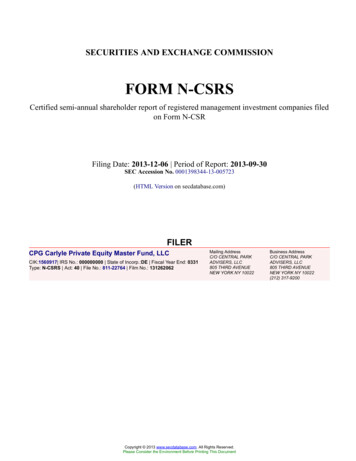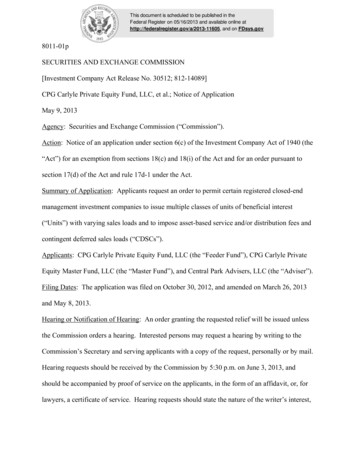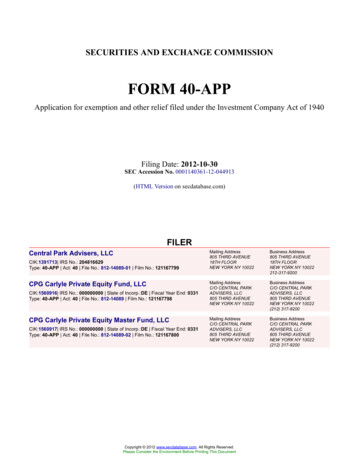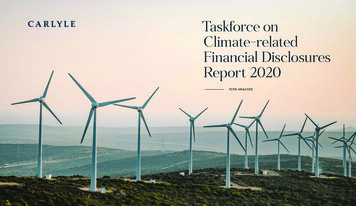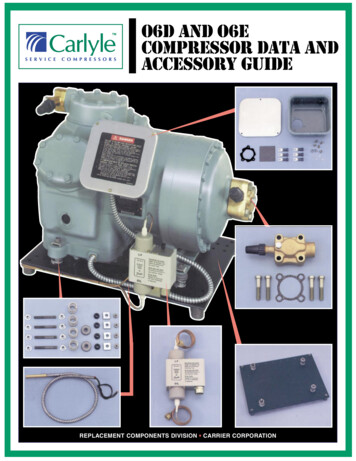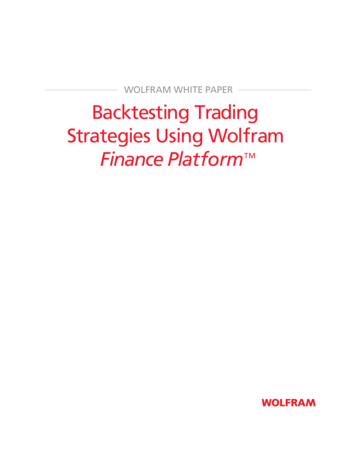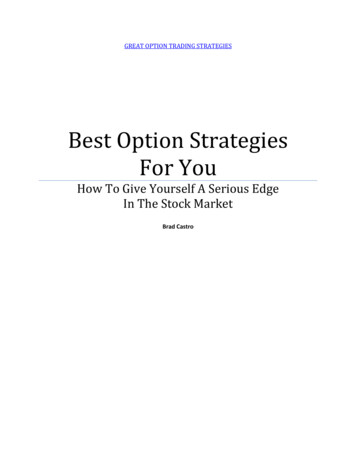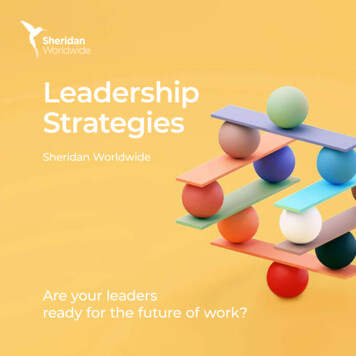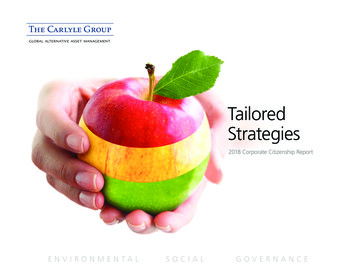
Transcription
GLOBAL ALTERNATIVE ASSE T MANAGEMENTTailoredStrategies2018 Corporate Citizenship ReportENVIRONMENTALSOCIALGOVERNANCECorporate Citizenship Report 20181
Just as apples have many varieties, so do our Environmental, Social and Governance (ESG)solutions. We believe that our portfolio companies benefit from distinct ESG strategies thatreflect their particular operations, sectors, geographies and stakeholders.We call this approach tailored strategies. Solutions tailored for each particular company'scircumstances enable our companies to address their material ESG risks and opportunities.Tailored strategies help to create maximum value for companies.ImproveenergyefficiencyDeliver ESGimproved productsand servicesIncreasetransparency andsustainabilityreportingAcquirebest-in-class ESGcertificationsCreate inclusiveand equitableworkplace culturesImproveworker healthand safety
One size fits noneCarlyle helps our portfolio companies and their senior management teams strategizearound a range of ESG issues, including environmental performance, workforce health andsafety, governance, and diversity and inclusion. Our tailored approach helps ensure thatCONTENTSPAGE2 Co-CEOs' Letter4About Carlyle6Our ESG Strategythese companies address the ESG issues that can have the biggest impact.GOVERNANCE & TRANSPARENCYIn this year’s citizenship report, we highlight in-depth case studies that demonstrate how8ESG Integrationspecific, tailored strategies can help companies create more value from ESG initiatives. We10CEP Enhanced Reporting Case StudyINDUSTRY LEADERSHIPalso describe how one of our largest funds, Carlyle Europe Partners IV, monitors portfoliocompanies through ESG Key Performance Indicators that enable an approach tailored to12Carbon Neutralitythe most material issues.13Climate Risk and ResiliencyVALUE CREATIONIn Carlyle's own operations, we too pursue an ESG strategy tailored to our business as14Building Capacityan alternative asset manager. We focus on the areas that drive the most value for our16ESG Value Driverslimited partners and unit-holders, and draw on our expertise and resources to be a leader18Case Studiesin our industry.INDUSTRY LEADERSHIP32Diversity & Inclusion34Driving Change36PhilanthropyCorporate Citizenship Report 20181
To our investors, our partners and our communitiesAs stewards of our investors’ capital, Carlyle’s mandate is to investwisely and create value. Over the last decade, one of the wayswe have strengthened our stewardship is through our sustainabilitypractice: quite simply, sound ESG practices enhance our investmentprocesses and outcomes. In this, our first annual letter as co-CEOs, we wantto assure our investors and other stakeholders that sustainability is and willcontinue to be an important priority for Carlyle.As Carlyle enters our second decade of ESG leadership, we are focused onthree priorities: value creation; robust governance and transparency; andindustry leadership on ESG issues.The theme of this year’s report—tailored strategies—captures the firstpillar of our ESG strategy. Each portfolio company and investment isunique, and we create the most value by tailoring ESG objectives andpriorities on a case-by-case basis. As a firm with more than 275 activeportfolio companies, we have learned that a one-size-fits-all solution doesnot serve our investors well.In essence, we encourage our investment professionals to prioritize thoseissues that matter most. Recent research from the Harvard Business Schoolvalidates this approach. The study found that firms that focus on andachieve success on material sustainability issues create more value (for moreinformation see page 14). In other words, many firms say they prioritizesustainability, but those firms that focus on the right issues—the materialones—generate the most value.At Carlyle, we possess strong internal capabilities, including a ChiefSustainability Officer and external specialists in specific ESG issues who helpus identify the materiality of ESG issues and provide insight to our investmentteams during the due diligence process. In the last year, we augmentedour existing investment process by adding the Sustainability AccountingStandards Board (SASB) sector guidelines as a resource. These guidelinesidentify material factors likely to create or destroy value in 11 sectors and79 industries. For example, if we explore an investment in an agriculturalproducts company, SASB points to several material sustainability issues2The Carlyle GroupOur ESG strategy: Tailored value creation Robust governance and transparency Industry leadership on ESG issuesto consider, including water use, fertilizer consumption and food safety.These sector guidelines, combined with our in-house expertise, allow us toapproach ESG strategically and focus on those issues that matter.The second pillar of our ESG strategy—governance and transparency—ensures alignment between Carlyle’s interests and those of our investors,and places a premium on effective communication with our investors andother stakeholders. We follow a rigorous process around ESG issues, withmandatory inclusion of these issues in Investment Committee materialsin most asset classes, and annual board-level review of our Guidelines forResponsible Investment at all of our controlled Corporate Private Equitycompanies. We also publish this annual citizenship report—our eighth—and regularly brief and consult with investors on ESG issues. We are excitedto announce that in 2017, one of our largest fund families, Carlyle EuropePartners, further advanced Carlyle’s ESG policies and practices by movingfrom fund-level reporting to reporting, on a company-by-companybasis, ESG Key Performance Indicators (KPIs). This enhanced frameworkgives our investors greater insight into the true ESG performance of ourportfolio companies.Carlyle’s third ESG pillar is to continue providing leadership on ESGissues, as we have for ten years. In 2008, we created our Guidelinesfor Responsible Investment, which also became the basis of theAmerican Investment Council's guidelines in 2009. We published thefirst sustainability report in the sector in 2010 and hired our first ChiefSustainability Officer, Jackie Roberts, in 2014.
We are pleased to announce that Carlyle, across our 31 global officesand the activities of our roughly 1,600 employees, is now carbon neutral.Over the past year, we conducted our first-ever carbon footprint analysiswith the assistance of environmental consultants with expertise in carbonmeasurement and estimation, and continued efforts to reduce our carbonemissions through efficiency projects. We then used our carbon data toinvest in an offset project with The Carbon Fund focused on reducingemissions from long-haul trucks, a service used by many of our portfoliocompanies. We are not aware of any other global private equity firm thathas taken this step. For more information on how we are deepening ourapproach to carbon and the climate, please see pages 12 and 13.Another area in which we aim to provide leadership is diversity and inclusion.Pursuing a diverse workplace not only reflects our values as a firm, butalso enables us to better serve our investors because teams with diverseperspectives and experiences make better decisions.In our 2017 citizenship report, when we chose to highlight ourprogress (and areas for further work) in hiring and promoting womenat Carlyle, we had no way of knowing that gender diversity wouldbecome a front-page issue by the end of the year. However, thespotlight only reinforced our belief that proactive leadership on theseissues is essential to our firm’s success and development. We are proudof our achievements and committed to even further improvements.This year, we are also proud to announce that the Human RightsCampaign gave us a perfect score of 100 for LGBTQ inclusiveness, theresult of inspired leadership by our LGBTQ Employee Resource Groupand support from senior decision makers at Carlyle. We believe thatsuch employee-driven initiatives help in all areas of diversity.We are humbled by your trust and hope this year’s corporatecitizenship report will further validate your confidence in Carlyle.“ The most effective ESG strategies are those with a clearconnection to how managing and improving ESG issuescreates value. A tailored strategy enables our deal teams toassess ESG risks and opportunities given their deep knowledgeof the companies and their stakeholders.”Kewsong LeeCo-Chief Executive OfficerGlenn A. YoungkinCo-Chief Executive OfficerCorporate Citizenship Report 20183
This is CarlyleThe Carlyle Group (NASDAQ: CG) is a global alternative asset manager with 201 billion of assets under management across324 investment vehicles as of March 31, 2018. Carlyle’s purpose is to invest wisely and create value on behalf of its investors.Our PurposeOur ValuesTo invest wisely and create valueService Act in the best interest ofRespect Value each other, encourageour investorsprofessional development, respectOur MissionIntegrity Uphold the highest standards ofGenerate superior investment returnsintegrity, professionalism and confidentialityInspire the confidence and loyaltyof our investorsQuality Deliver best-in-class investmentactivities and services to our investorsAttract, develop and retain highlytalented professionalsStewardship Treat our investors’Demonstrate principled industry leadershiprisk and rewardBe responsible and respected membersof the global communityAccountability Take personal responsibilitymoney as if it were our own, balancingand deliver on commitmentsTeamwork Create community and worktogether as One Carlyle4The Carlyle Grouppersonal contributions and rewardeffective performanceCitizenship Be responsible citizens in thecommunities where we work and liveEntrepreneurship Differentiate the firmthrough creative thinking and actionDetermination Show a will to win in everyaspect of our business
Our investments in more than275 portfolio companies1,750 investorsfrom 83 countriesemploy more than650,000 employeesBusiness Segments4Corporate Private EquityReal AssetsofficesGlobal CreditInvestment SolutionsKey Industry SectorsAerospaceDefense & Government Services1231Consumer & RetailEnergy & Power19countries6continentsCarlyle professionals work togetherFinancial ServicesHealthcareIndustrialInfrastructure650 investment professionalsReal EstateTechnology & Business ServicesTelecommunications & MediaTransportationO N E C A R LY L E1,575 Carlyle employeesseamlessly and selflessly across funds,industries and geographies to deliverthe wisdom, knowledge and resourcesrequired to invest wisely and createvalue for our investors. We call ourcollaborative spirit One Carlyle.All data as of March 31, 2018.Corporate Citizenship Report 20185
Our ESG strategyAt Carlyle, ESG issues intersect with our business in several different ways. We focus on three goals in our ownstrategy and work to make progress in each area.Providing strong ESG governance and transparency Since 2008, we have sought to continuouslystrengthen governance and transparency, ensuring that the interests of our investors, portfolio companiesand investment professionals are aligned with our ESG goals. Good governance processes enable Carlyle tomonitor current and emerging risks and provide investors with the transparency they require.Creating value through tailored strategies at portfolio companies ESG considerations play a growingrole in our investment processes and the operations of our portfolio companies. As part of our investmentprocess in our Corporate Private Equity segment and several other asset classes, we evaluate ESG risks andseek opportunities to create value through sustainability initiatives. During our ownership period, we supportour management teams’ efforts to develop strategic ESG programs, including through collaboration with otherportfolio companies. At exit, we highlight relevant ESG accomplishments. Our case studies and ESG value drivers(see page 16) illustrate the range of opportunities for enhancing value.Advancing ESG practices in the private equity industry Our tailored ESG strategy includes advancingESG issues within our own firm. For example, we believe that diverse teams and experiences bring tremendousvalue to our firm and our industry. As such, we work to cultivate an environment rich in different backgrounds,perspectives and experiences. We participate in ESG events and organizations, aiming to stay at the forefrontof emerging issues such as climate risk. We encourage our employees to get involved where they live, work andinvest through our volunteer and wealth sharing programs. We also work to continually improve environmentalstewardship within our firm, particularly in the areas of energy and materials use.6The Carlyle Group
2value creationat portfoliocompanies ESG1 governance&transparency3best practices inthe private equityindustryCorporate Citizenship Report 20187
GOVERNANCE & TRANSPARENCYHow we integrate ESG considerationsinto our investment processCarlyle integrates ESG into our investment process to identify and monitor the most relevant ESG issues,therefore reducing risk and creating value. We provide our deal teams and portfolio companies withthe resources and information they need to manage ESG issues effectively. While risk managementstrategies frequently evolve over time, we are increasingly confident in our ability to identify and manageESG risks, including responding to incidents if they occur.We formalized this approach through internal policies and processes that seek to improve ESGgovernance through three key approaches: Our Guidelines for Responsible Investment Developed in 2008, our guidelines were the basisof the industry standard adopted by the American Investment Council. These guidelines provideour global deal teams with a clearly defined policy to follow during the investment process. Theguidelines—which draw on international standards, including the UN Principles for ResponsibleInvestment and the UN Global Compact—can be viewed at www.carlyle.com/citizenship. An annual review by all controlled Corporate Private Equity (CPE) boards to affirm adherenceto the policy. In 2017, 96% of Carlyle-controlled companies in our CPE segment reviewed theiroperations in accordance with our Guidelines for Responsible Investment.1 A review of material issues during due diligence that is shared in the Investment Committeememo and included in the deal’s transaction dashboard for most asset classes.1 Three of the four companies who failed to review the guidelines were in active exit processes and left our portfolio in early 2018.8The Carlyle Group
ESG expertise and executionOur Chief Sustainability Officer (CSO) and her team support investment professionals, portfoliocompanies and our investors on ESG issues. She also engages with the broader financial and ESGcommunities to advance sustainability in the private equity industry and provides training and supporton a variety of related issues. We engage external experts as appropriate for environmental and socialassessments in due diligence and to help develop and implement mitigation plans in areas needingcorrective action.Carlyle professionals receive training on ESG issues on a regular basis. Our CSO meets with theincoming class of associates every year and presents at our Vice Presidents Forum and SeniorLeadership Conference concerning new developments in the space. Our employees also receivetargeted training on many issues related to corporate governance and compliance, including anticorruption, conflicts of interest, economic sanctions and anti-money laundering. Our Office ofGeneral Counsel provides expertise and support on all governance issues.During due diligence, and continuing into ownership, investment professionals access relevantexpertise through several channels, including input from our sustainability team, expert consultantswho may conduct specific ESG assessments and third-party guidance, such as the SASB standardsthat we incorporated into our process in 2017. SASB helps us define material ESG risks and areas ofconcern for stakeholders and begins to create a road map for highlighting which areas might createvalue for various stakeholders if managed well.“ The most important aspect of what I do isto understand the range of ESG issues thatintersect with business—what are the mostmaterial issues for different sectors and howcan we provide more support on ESG issues toreduce risks or create value.”JACKIE ROBERTSCHIEF SUSTAINABILITY OFFICERCorporate Citizenship Report 20189
GOVERNANCE & TRANSPARENCYCarlyle Europe Partners: First fund to provide ESG reportingat the portfolio company level for all LPsIn 2017, Carlyle Europe Partners (CEP) augmented Carlyle’s global ESG goalsand practices by introducing its own enhanced ESG framework, starting withthe latest vintage of its funds, Carlyle Europe Partners IV. Based in Europe andreporting to fund Co-heads Gregor Boehm and Marco De Benedetti, Eimear” We believe that a focus on ESG is important,not just because it is the right thing to do,but because it makes good business sense.Over time, we observed across our portfoliothat businesses that identify and focus onthe material ESG issues outperform. OurPalmer leads Carlyle Europe Buyout's ESG efforts, working closely with Carlyle'sCSO to ensure a streamlined approach to detecting and managing ESG risksand identifying ESG opportunities. CEP’s enhanced ESG framework involvessystematically establishing and monitoring company-specific ESG KPIs for eachcontrolled private equity investment.CEP has established a three-step process for setting ESG KPIs:ESG framework gives us a systematic andmeaningful way to monitor material ESG1. First, to establish a baseline of issues for discussions, the deal teamrisks and identify ESG opportunities.”reviews SASB guidance to determine the key ESG issues for each portfoliocompany’s industry sector, consults with our Chief Sustainability OfficerMARCO DE BENEDETTI AND GREGOR BOEHMabout issue materiality, and, if necessary, engages external consultants toMANAGING DIRECTORS AND CO-HEADSidentify issues specific to the business.CARLYLE EUROPE PARTNERS2. Next, the team collaborates with management to formulatecompany-specific ESG metrics that are relevant and meaningful foreach individual company and can be monitored regularly.3. Finally, the Carlyle Europe team annually updates an ESG KPI reportingtemplate for each portfolio company to highlight its key ESG challenges andopportunities, based on the company’s sector, geography and size.Establishing company-specific ESG KPIs is now included as standard in the100-day post-acquisition plan for each new Carlyle Europe investment. Thenumber of ESG KPIs varies by company, depending on the sector and thequality of the company’s ESG management system. Each ESG KPI is monitoredannually and discussed with management. Any ESG concerns identified duringthis process will be raised at the portfolio company board level.10
SASB Materiality MapCarlyleEuropePartnersSocial CapitalESG KPIsKey performance indicators (KPIs)are helping us monitor materialESG risks and opportunities toenhance Carlyle Europe investmentsEnvironmentHuman CapitalCorporate Citizenship Report 201811
INDUSTRY LEADERSHIPmeasureCarbon neutralityAs the next step in strengthening ESG practices in our own operations, we are proud to announce thatCarlyle, across our 31 global offices and the activities of our roughly 1,600 employees, is now carbonneutral, starting with our 2017 carbon footprint. Carlyle sees an opportunity to demonstrate leadership inour industry by measuring, reducing and offsetting our emissions.Measure We gathered data on all of our major sources of carbon, including utilities in our offices,off-site data centers and business travel, covering Scopes 1, 2 and 3 in the World Resources Institute'sGreenhouse Gas Protocol. Anthesis Group, a third party with expertise in carbon footprinting, helped usreview and refine our methodology to calculate our carbon footprint.reduceReduce We continue to look for opportunities to reduce our use of energy, water and resources in ouroperations. Our Global Technology & Solutions team engaged in significant virtualization of our serversand centralization of our printing resources, generating energy and material savings, including a 15.9%reduction in our data center energy use over the last year. We renovated and relocated to more efficientspaces at several locations around the globe, including our new London office, which was certified"Excellent" by BREEAM, the British green building standard. Our U.S. offices in New York and Rosslyn,Virginia earned LEED and Energy Star certifications.Offset With our measurements and reductions in hand, we worked with The Carbon Fund, an organizationthat provides verified carbon-offsetting projects, to purchase enough offsets to achieve carbon neutrality. Theyhelped us identify a truck stop electrification project, verified by the American Carbon Registry, to offset theremainder of our footprint. This project averts carbon by installing electrical hookups at truck stops throughoutoffsetthe United States for use by truck operators during their federally mandated rest period, rather than relyingon diesel generators or idling to produce electricity. The reductions in carbon come from the difference incarbon intensity between grid electricity and diesel combustion, combined with the fact that the solution isnot yet commercially viable without the sort of investment Carlyle is providing. In addition to carbon benefits,electrification reduces conventional air pollutants, which is healthier for truckers at these locations and theirsurrounding communities. Since many of our portfolio companies rely on ground shipping for supplies and/ordelivery of products, reducing emissions from trucking is important across our portfolio.12The Carlyle Group
INDUSTRY LEADERSHIPClimate risk and resiliencyTesting our own climate resilience In 2017, what began as a tabletop exercise in businesscontinuity planning quickly evolved into a climate risk exercise as our team concluded thatweather-related risks outpace other risk categories in terms of scope and probability of occurrence.Georgette Kiser, Carlyle's Chief Information Officer, led the exercise.This exercise led to three outcomes: focusing on physical safety to complement continuity; rearrangingthe Carlyle communications tree; and recognizing vulnerabilities in our U.S. data center structure thatled us to explore additional backups (including cloud technology).Climate resiliency in our portfolio After Hurricanes Harvey, Irma and Maria in 2017, our internalanalysis showed little damage to our assets directly, partly due to better preparedness. For example,one of our portfolio companies, Clearly Petroleum, owns a field along the Brazos River in Texas that issubject to flood risk. Prior to the landfall of Hurricane Harvey in August 2017, Clearly’s field personnelpreemptively shut in the field and filled storage tanks with water at the production facility to preventflotation. Clearly had previously taken several steps to minimize potential impacts from adverse weatherevents, including expanding berms around storage tanks and elevating electric equipment.Carlyle's portfolio companies continue to pursue business continuity planning that takes extremeweather risks into account. Philadelphia Energy Solutions and Fort Lauderdale Marine are two moreof our large assets where Carlyle teams invested in new procedures for storm preparedness. Forexample, the Philadelphia Energy team elevated key equipment to account for new floodplain maps.“ I am a strong advocate for tabletop exercises,which are meetings to discuss simulated“Risks are dynamic, and there is no question that climate risk and resiliency are emerging issues foremergency situations. Our own exerciseinvestors,” says Carlyle Chief Risk Officer Bruce Rosenblum. “Business continuity planning shouldon climate risk helped us prioritize physicalexpand to include these risks.”safety, modify our company communicationstree and explore the implementation ofbackup data centers.”GEORGETTE KISERMANAGING DIRECTORCHIEF INFORMATION OFFICERCorporate Citizenship Report 201813
VALUE CREATIONAnnual sustainability workshophelps portfolio companies shareideas and build ESG strategiesIn December 2017, Carlyle gathered a group ofportfolio companies in Washington, DC to discusssustainability trends and emerging issues and toshare ideas. In this latest edition of a recurringevent, the sessions focused on how we can helpour portfolio companies identify and transformtheir ESG initiatives into full ESG strategies. Weconsidered how to create value by integratingnot just the most material ESG issues, but alsoinput from key stakeholders, including customers,investors, employees, suppliers and communities.Our investment professionals discussed howour value creation strategies align with ourfour sustainability value drivers. Carlyle’s ChiefInformation Officer, Georgette Kiser, led a sessionon weather risks and tabletop exercises, using aclimate change risk assessment for Carlyle’s ownbusiness operations (see page 13).The group was inspired by George Serafeim'sresearch from Harvard Business School, whichaffirms that the most effective ESG strategiesreflect a solid understanding of how managingand improving ESG issues creates value. In contrast,those strategies that miss the right issues tend tosimply spend money on initiatives that may bemisdirected and add minimal value.2(left to right) Brian Bernasek, Managing Director and Head of Global Industrial &Transportation Team, and Jay Sammons, Managing Director and Head of Global2 Mozaffar Khan, George Serafeim, and Aaron Yoon. CorporateSustainability: First Evidence on Materiality. The Accounting Review:November 2016, Vol. 91, No. 6, pp. 1697-1724.14The Carlyle GroupConsumer & Retail team, with Jackie Roberts, Chief Sustainability Officer.
How our sector heads see the evolving role of ESGBrian Bernasek and Jay Sammons head our industrial and consumer and retail sectors for our U.S. Buyout team, respectively. At our 2017 Portfolio CompanySustainability Workshop, they discussed the value and importance of ESG in their specific sectors, which we summarize below:How do you see value in ESG initiatives?JAY: At the beginning of my career, ESG was seen by most as being mutuallyexclusive with profit. Things are different today. I focus on consumer-facingbusinesses, and a key impetus to improve our ESG performance comesstraight from the end-consumers themselves. They’re savvier, they have moreaccess to information than ever before, and they want to buy from companieswhose operations they respect, that reflect their own values and have moredistinctive product attributes, such as more sustainable products.BRIAN: We’re definitely doing more on the growth side, but the cost sideis still an essential driver for ESG initiatives. Improving operational efficiencyis a priority in any new investment, especially carve out transactions. Weoften get strong energy and water savings from that process. After that, wecan move on to growth strategies. Axalta is an industrial coatings companythat responded to customers who needed better ESG attributes in paint andcoatings by developing new, environmentally preferable formulations. Thishelped grow the business with new customer bases en route to an IPO.What does it take to identify or develop a culture of ESG success in aprospective investment?BRIAN: If you’re not on top of safety, governance, environmental impactand the like, it is a sign that your overall operations are not tightly run. Assuch, it’s very much a part of the broader management culture. In terms ofmeasuring impact, many areas of ESG are harder to quantify, although we’reincreasingly measuring KPIs where appropriate. For the areas that are morequalitative, you focus on your customer and encourage a strong ESG culture.JAY: A big part of our job is pattern recognition, and through experienceand instinct, we just know when a company’s leaders believe in good ESGmanagement and when they do not. Some of it is quantitative, but a lot ofit is intuitive. A key focus for us is to make sure ESG issues and opportunitiesare discussed at the portfolio company board level, because if they aren’t,they likely won’t be discussed or implemented anywhere below it. So, wemust start by getting the board membership right in order to driveESG opportunities.BRIAN: ESG used to be about playing defense, or what we would call“reputational risk.” It’s now an offensive, value-improvement tool. It’s goodfor business. The best way we measure that is by our performance.What is driving the business case for ESG integration?JAY: It’s information. Consumers are more powerful than ever beforebecause they have so much more information in hand—she can look thingsup on her phone when she's standing at the shelf making a decision betweenbrands. And, millennials—their ways of consuming are totally different, so weneed to pay close attention when demographics change.BRIAN: And once the business case becomes clear, the boards andmanagement teams of these companies start to drive ESG change themselvesbecause they see the value.What is the biggest mistake that companies make with regard to ESG?JAY: Treating ESG like a check-the-box exercise. Board reviews can’t just betools to measure—the culture has to be built where ESG is considered ineverything people do all around the organization. It’s not the work for the sakeof the work. It’s not just about compliance. That type of approach can lead to asituation where there is a spread between aspiration and quality execution.BRIAN: I’ve never seen a mistake when they’ve made an honest attemptat it. The place where the mistakes are made is when they’re not committedto ESG in the first place. If anything, the
companies. We also publish this annual citizenship report—our eighth— and regularly brief and consult with investors on ESG issues. We are excited to announce that in 2017, one of our largest fund families, Carlyle Europe Partners, further advanced Carlyle's ESG policies and practices by moving
